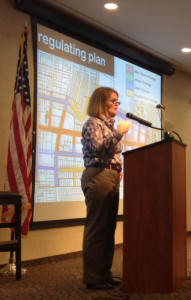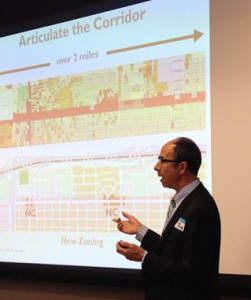FBCs: From Fringe to Mainstream in 10 Years
On this Tenth Anniversary of FBCI (we were incorporated on May 27, 2005), it is my pleasure to welcome readers to the inaugural issue of FBCI’s e-Newsletter. I have the privilege of serving as the first full-time Executive Director of FBCI, beginning in November of 2014 and building on the excellent work of my part-time predecessor and co-founder of FBCI, Carol Wyant. Carol worked with our distinguished Board of Directors to get us off the ground and chalk up an impressive track record (see Carol’s article). She remains on the Board and has given me invaluable guidance as I learned the ropes for this exciting challenge.
In the ten years since FBCI was established, form-based codes have become a well-established regulatory tool that has moved from the fringe to the mainstream in contemporary planning practice. FBCI has changed the national conversation about the reform of development regulation and ushered in a new chapter in the history of planning and zoning. In successive issues of this newsletter, I will describe what FBCI has been doing and where it is headed in the future.
While form-based coding is now well recognized as a state-of-the-art tool, only about 1% of municipalities in the US have adopted a form-based code. The challenge for the coming years is to move from recognition of FBCs as an accepted tool, to making them the tool of choice for creating, enhancing, and transforming great places for people to enjoy. This means that they have to be more broadly understood not only by planning practitioners, but also by public decision makers and their constituents. FBCI is committed both to spreading the word and improving the practice through our education program, technical assistance, and marketing.
Recent years have seen the adoption of form-based codes by several major cities, including Miami, Denver, Nashville, and Cincinnati, as well as numerous smaller cities and individual downtowns, neighborhoods, and corridors. For the first time a county has adopted a FBC: Beaufort County, South Carolina, which won the Driehaus Form-Based Code Award this year. This is great progress, but it is still just the tip of the iceberg. There is so much left to do.
In order to grow the practice, we have to see it in a broader perspective, a perspective that will be understandable beyond the narrow guild of technical practitioners. This means that we need to communicate in layman’s terms why zoning needs to be reformed, and why the prevailing Euclidean paradigm needs to be shifted toward regulations that will predictably result in walkable places that people cherish. That is also the challenge of the New Urbanism, whose new CEO, Lynn Richards, has challenged us all to work together and broaden our base among different professionals and the general public.
At FBCI, we will meet this challenge with the help of our supporters and members to transform the practice of planning, regulation, and place-making. We have launched our first membership and fundraising campaign, with the generous support of the Richard H. Driehaus Charitable Lead Trust. Donations made to FBCI through September, 2015 will matched on a 2:1 basis by the Trust. Please see our members and donors, listed in the newsletter, and join us in our efforts!
















